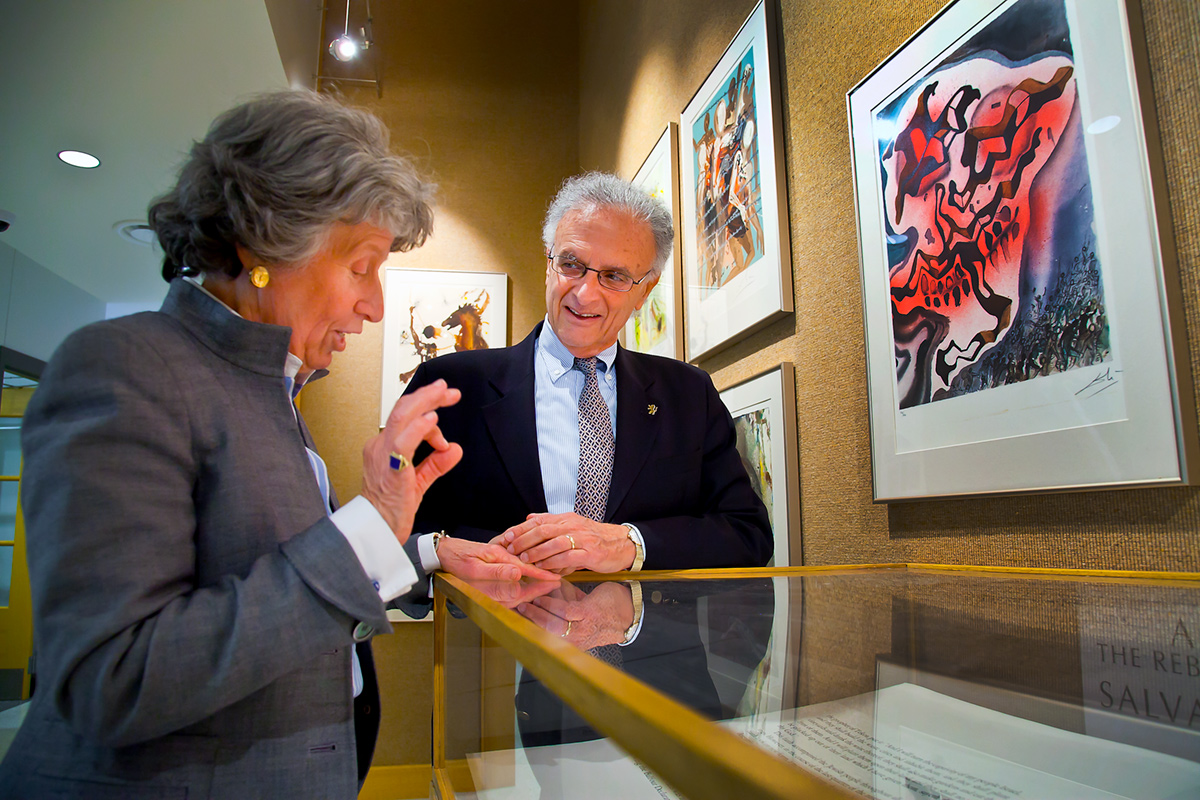Dali Lithographs at Hillel

Kay Hinton
The muted walls of the Marcus Hillel Center provide a perfect backdrop for the passionate colors of Salvador Dali’s Aliyah: The Rebirth of Israel, a little-known suite in which the late Spanish surrealist portrays the epic history of the Jewish diaspora and the return to the homeland.
Ursula Blumenthal purchased the limited-edition lithographs many years ago as a gift to her husband, Emory Professor David Blumenthal, in memory of their first date in 1965, on which they went to see an exhibit of Dali’s paintings at the Huntington Hartford Museum in New York. The set of twenty-five colored prints was kept in its original box and stored safely under the couple’s piano for nearly thirty years, until Ursula Blumenthal had the idea of displaying the series at Emory’s new Marcus Hillel Center. “I am so glad it’s here where it can be seen and appreciated,” she says.
The Marcus Hillel Center opened last spring and was dedicated in September. Home Depot cofounder Bernie Marcus, for whom it is named, donated $3 million to the $9.2 million total campaign. The 10,500-square-foot facility, on Gatewood Road just across from the old Hillel Center, contains meeting rooms, a kosher cafe, and gathering and worship spaces. “This should not be just a destination, but a center from which Jewish life emanates on campus,” says director Michael Rabkin. “We want to enrich the lives of Jewish students so they may enrich the Jewish people and the world.” A third of Emory freshmen with religious affiliation identify as Jewish, he says.
David Blumenthal, the Jay and Leslie Cohen Professor of Judaic Studies in Emory’s Department of Religion, also curated the Aliyah exhibit, which had its formal opening March 17 and will remain on loan through June. “Dali was commissioned to do this suite, which led some to believe it’s not serious work,” he says. “I believe it was serious, commissioned work.”
“There are no accidents with Dali,” adds Ursula Blumenthal. “He worked very carefully, very deliberately.”
The original Aliyah works took two years for Dali to complete and were commissioned by Shorewood Publishers, a New York firm noted for art publications. After its grand opening at the Huntington Hartford Museum’s Gallery of Modern Art in New York on April 1, 1968, 250 sets of twenty-five lithographs each were produced and then the stones were destroyed, ensuring that there would be no more reprints; the Blumenthals’ (number 150) is the only known set in Atlanta.
For the Hillel exhibit, Blumenthal has organized the lithographs—all of which are signed and many of them dated—historically and thematically. A favorite section is the four iconic images of exile and hope: “A Voice Is Heard in Ramah,” “The Wailing Wall,” “For That Is Thy Life and the Length of Thy Days,” and “Return, O Virgin of Israel.” “The Hebrew word aliyah means ‘ascent’; in later Hebrew, it was broadened to mean ‘to ascend to the land of Israel,’ ” Blumenthal says. “After centuries of oppression in the exile, aliyah is a commitment to the rebirth of the Jewish people, to the renaissance of the Jewish spirit, in its own space.” Despite critics’ contention that Dali was anti-Semitic or driven solely by a desire for profit, Blumenthal sees a deeper understanding communicated through the thoughtfulness of the Aliyah series. “When he handled Catholicism, he was aggressively Dali,” Blumenthal says. “But, in regard to Zionism, he is more respectfully Dali.”






